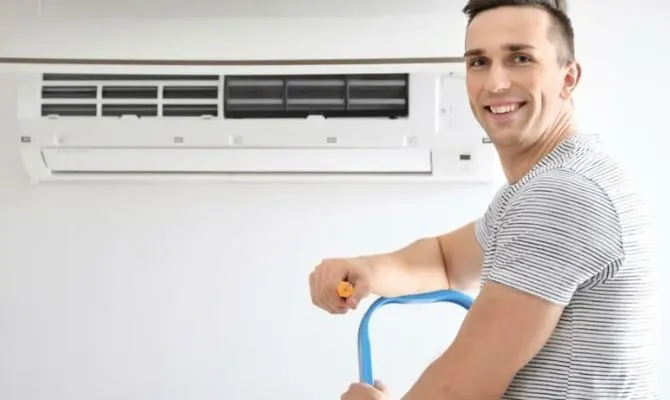During those long, cold, snowy winter months, we long for hot, sunny summer weather. But be careful what you wish for! Sometimes extremely high temperatures and humidity can make life uncomfortable. The solution? Central air conditioning. The push of a button can make the difference between sleepless nights and hours of cool, comfortable slumber. And although we might enjoy spending our days soaking up the rays in our backyards, or on our patios and balconies, sometimes we need a little indoor relief so we can cook and relax in cool comfort. So, hooray for AC! But how does it work? Well, it’s not rocket science, but it is science – physics, in fact.
How Does a Central AC Work?
If you remember your high school physics, you will recall that gas always cools as it expands. This is the basic principle behind central air conditioning. The components in an air conditioning unit cause the expansion and condensing of a refrigerant gas, carefully controlling and directing it, resulting in cool air in your home.
Simply put, a central air conditioner system is like a giant refrigerator for your house. The system’s components perpetuate a cooling cycle, in which a cool refrigerant absorbs heat from the indoor air and expands into a warm gas. It then travels to an outdoor unit (nicely located in your backyard), where the heat is expelled and turns into a cool liquid. It then returns back indoors through ductwork to absorb more heat and the cycle continues.
Five main components work together to accomplish this operation:
The Refrigerant
The refrigerant changes from a gas to a liquid state as it collects the heat from your house and ejects it outside.
The Compressor
The refrigerant requires a compressor to pump it. Much like a heart, it pumps the refrigerant through the components in a big copper loop.
The Condenser
The condenser enables this transformation. In the condenser, the hot refrigerant vapour is cooled as it passes through the coils of the condenser. The condenser is equipped with a fan that speeds the cooling of the vapour inside the coils. As it cools, the refrigerant changes from a hot vapour to a hot liquid, then moves to the expansion valve.
The Expansion Valve
In most AC systems, the compressor, condenser coil and expansion valve are located in a condensing unit situated outside your home. The expansion valve does the actual cooling. The hot liquid refrigerant passes through the valve at high pressure on one side, and emerges as a cool low-pressure mist.
The Evaporator Coil
For the final step, this cool mist runs indoors to the evaporator coil. This component is located in a box between the furnace and the ductwork. The warm air inside your home blows across the coil and heats it, while the coil carrying the now-expanded refrigerant gas cools off the air blowing across the evaporator. This cooled air is circulated through the ductwork, cooling the air in your home.
The refrigerant then starts to heat up and boil, transforming from a cold liquid to a warm vapour (in other words, evaporation), then it goes back to the compressor and outdoor condensing unit, where it expands and cools again, continuing the cycle.
Where do you come in?
The thermostats in your home are the controls for turning the system off and on, and you control the thermostats, adjusting the temperature to your comfort level.
Keep Your Cool
Your air conditioning system is an important part of your HVAC system and requires some basic maintenance to keep running smoothly. You may have a maintenance contract with our HVAC team, in which case a technician will check, clean and repair your system at the beginning of the season, or as required if problems arise. But if you are a confident do-it-yourselfer, you can perform some of these tasks on your own:
- Monthly or seasonally, you can check the refrigerant lines. In the summer, you can turn off the water that supplies your furnace’s humidifier. In the fall, you should replace the humidifier filter and turn the water back on.
- Remember to replace the battery in your carbon monoxide detector.
- Ensure that your outdoor AC unit is on level ground and free of debris.
- Clean the AC condensate drain with a water and bleach mixture.
- And of course, always consult the manufacturer’s directions for maintenance and troubleshooting tips.
Now, sit back and enjoy the summer!



